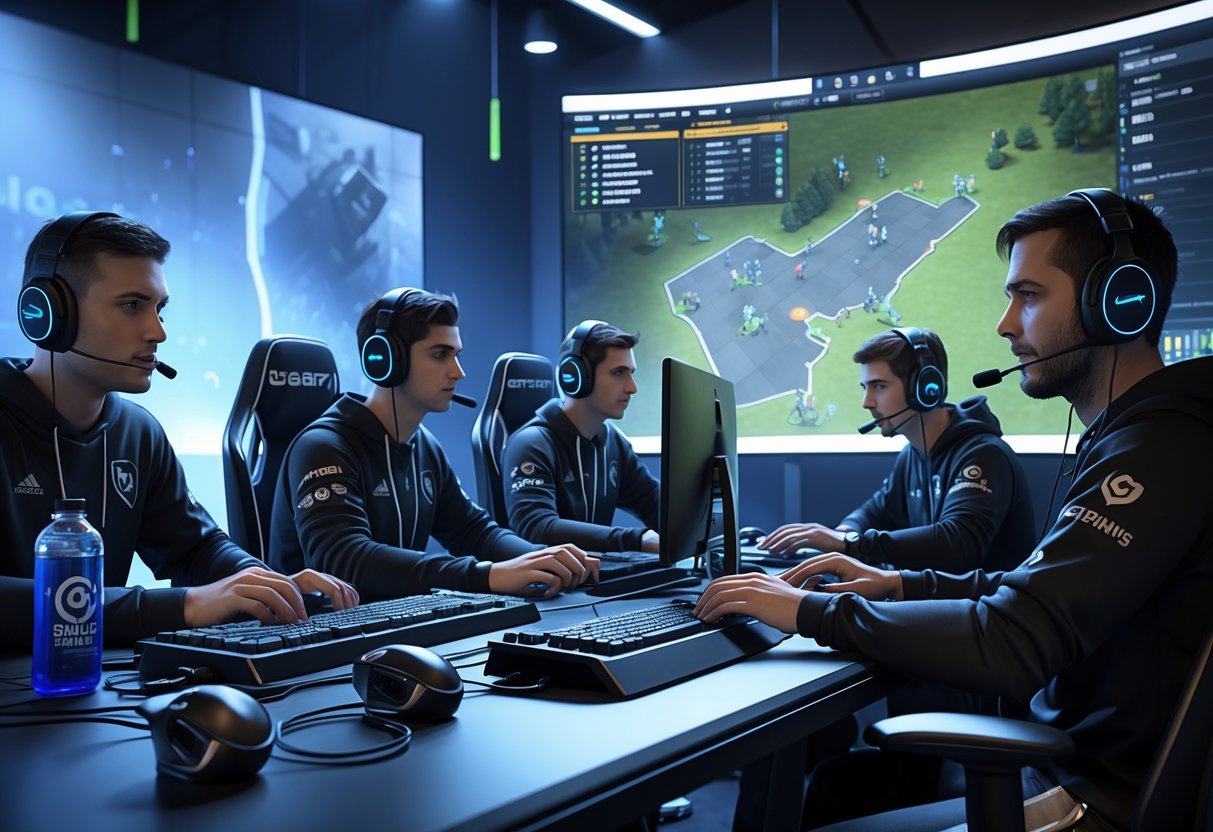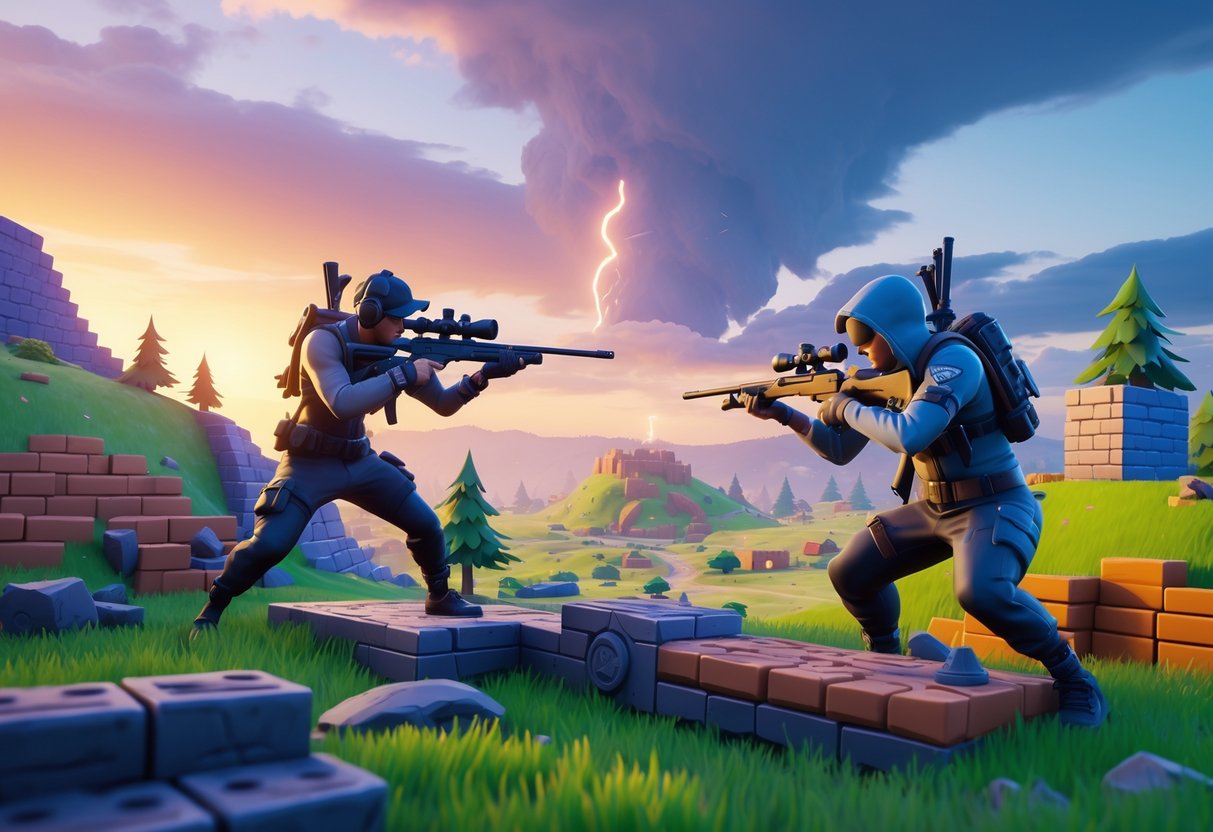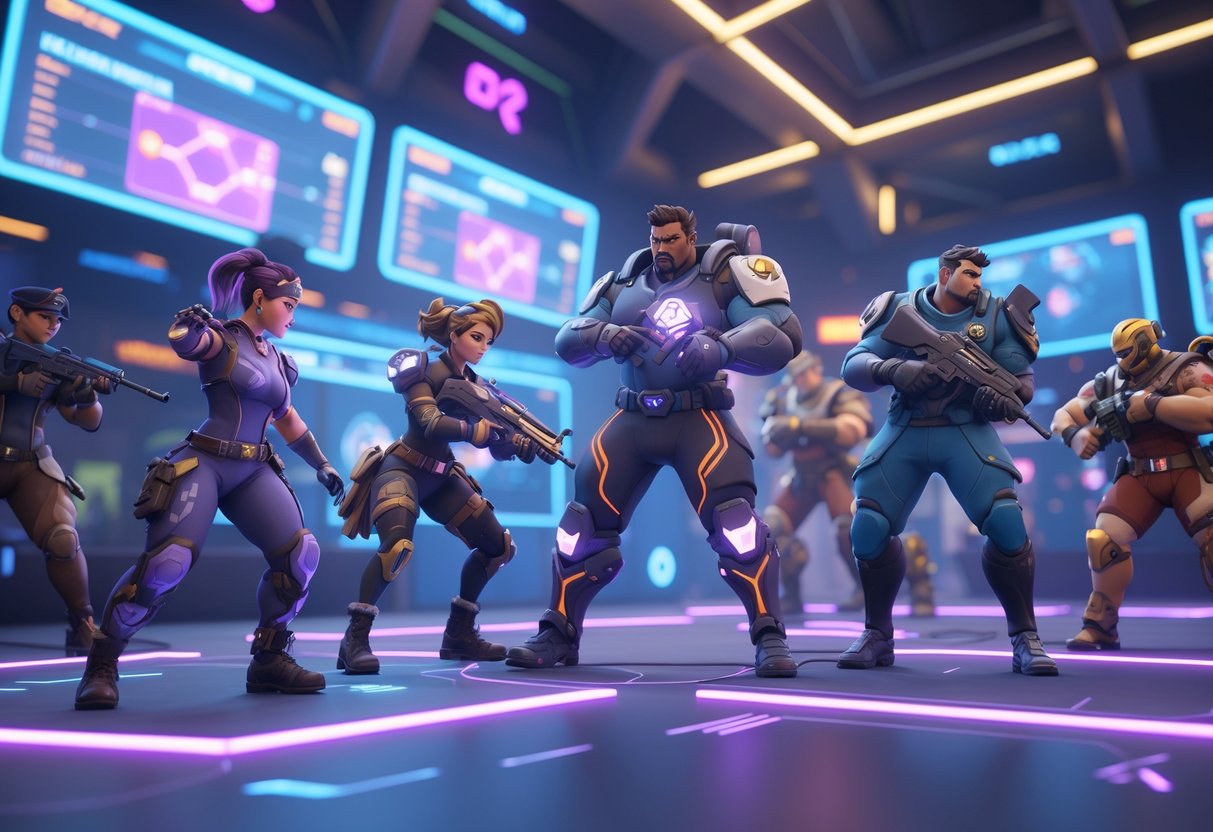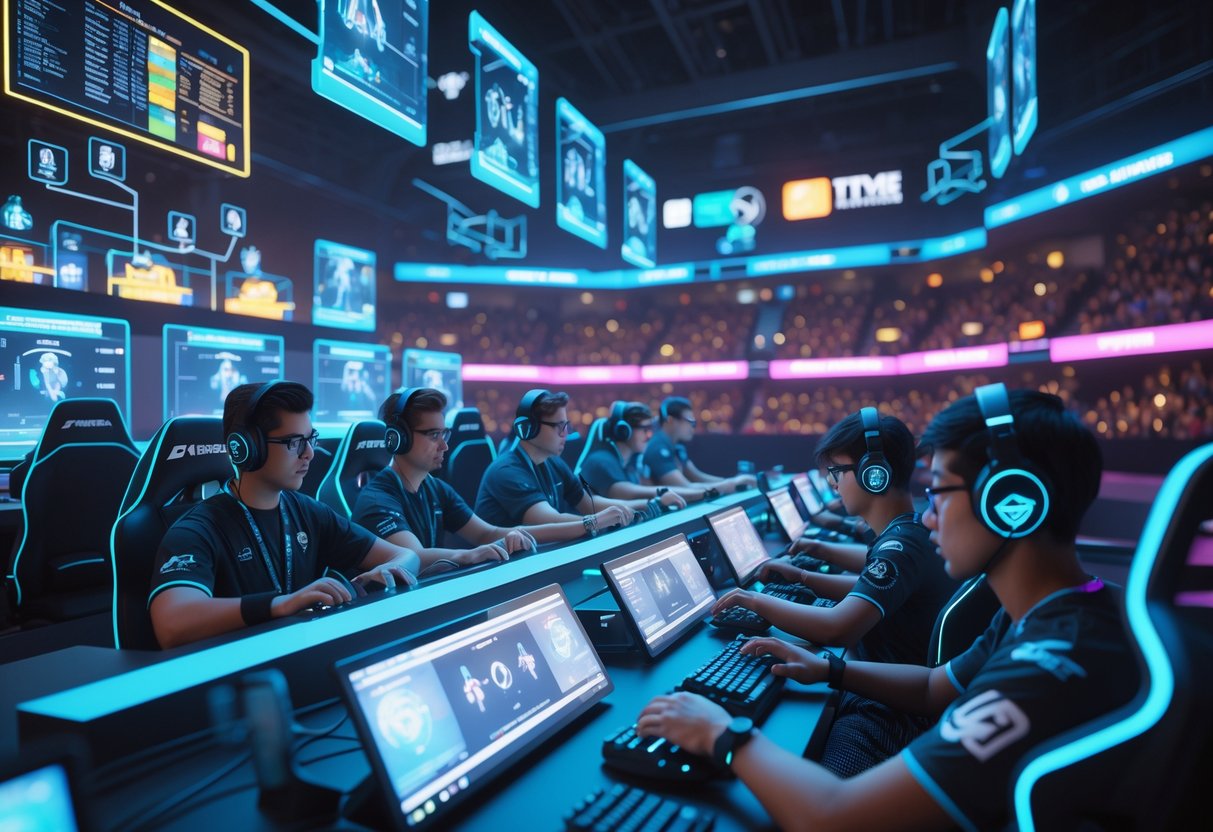Scrim Culture Explained: A Deep Dive into Esports Practice
Updated On: November 12, 2025 by Aaron Connolly
Scrim Culture Explained: The Core Concepts
The word “scrim” comes from “scrimmage,” which means a practice match where teams face off with no rankings or prizes on the line.
Players use these organized training sessions to build skills, try out strategies, and get ready for tournaments in a competitive but less stressful setting.
Origins of the Term Scrim
“Scrim” grew right out of traditional sports lingo. It’s just a quick way to say “scrimmage,” a word for practice matches or drills.
In traditional sports, scrimmages have been around forever. Football teams run scrimmages at training camp.
Basketball squads hold them before the season even starts.
Esports teams picked up the idea pretty naturally. Early competitive gaming groups needed ways to practice too, so they grabbed the term and shortened it for fast typing in chat rooms.
The gaming community ran with it because it nailed what these matches were: serious practice, no official consequences.
Now, “scrim” pops up in every major esports scene. Counter-Strike teams run scrims every day.
League of Legends squads schedule a bunch each week. Valorant players drop “scrim” into Discord chats constantly.
The word spread through forums and streams. Pro players mentioned it on broadcasts.
Before long, both casual and hardcore players knew exactly what a scrim was.
Meaning of Scrimmage and Skirmish
A scrimmage is an organized practice match between two teams. Everyone focuses on improving, not on winning prizes or rankings.
Key characteristics of scrimmages:
- Private lobbies or custom games
- Only coaches watch, no outside spectators
- Rules both teams agree on
- Emphasis on testing strategies and teamwork
A skirmish is a bit different. It means a smaller fight or quick clash.
In gaming, skirmishes usually mean short bursts of team fighting during a match.
A friendly game sits between casual play and full-on scrims. These games have more structure than random matches, but they’re not as intense as official scrims.
Sometimes players stream friendly games or let viewers watch.
Here’s how they stack up:
| Type | Purpose | Audience | Rules |
|---|---|---|---|
| Scrim | Serious practice | Private/coaches only | Strict team rules |
| Friendly game | Casual competition | May include viewers | Relaxed approach |
| Skirmish | Brief encounters | Varies | Standard game rules |
Purpose of Scrims in Esports
Teams set up scrims to sharpen their edge before big tournaments. Scrims show weaknesses that solo queue games just can’t.
Scrims help with three main things in competitive gaming:
Teams work on strategy development during scrims. They test new tactics against skilled opponents.
They try out different character picks or weapons. This lets them tweak things before the real matches.
Team coordination gets better with scrims. Players practice callouts and timing.
They figure out each other’s play styles. Communication gets smoother and faster.
Opponent analysis is the third big perk. Teams study how others handle situations.
They spot patterns in enemy strategies. This info comes in handy when tournaments roll around.
A lot of pro teams treat scrims like a regular job. Some run three scrims a day during training.
Each session usually lasts one or two hours, depending on the game.
Amateur teams use scrims too, but with a different focus. They work on basic teamwork instead of advanced tactics.
Scrims help them move from casual play to more serious competition.
How Scrims Work in Competitive Gaming
Teams set up scrims by reaching out to other squads directly or through community platforms.
Most scrims follow formats with agreed rules that copy tournament conditions, but with tweaks for practice.
Arranging and Scheduling Scrims
Finding scrim partners takes a bit of hustle and networking. Most teams start by contacting squads with similar skill through Discord, managers, or scrim-finding sites.
Popular ways to find scrims:
- Team Discord servers and channels
- Social media connections
- Scrim-finding websites and apps
- Tournament organizer platforms
- Direct contact through friends or teammates
Pro teams usually have a network of regular practice partners. They book scrims weeks ahead, especially before tournaments.
Amateur teams set up scrims with less notice.
Timing is a big deal. Teams juggle different time zones and player schedules.
Most scrims happen in the evening, after work or school.
Quick win: Jump into your game’s main Discord to find scrim partners at your level.
Format and Rules of Scrims
Scrim formats change by game, but they usually copy tournament setups.
Teams agree on rules before they start to get the most out of the session.
Common scrim formats:
- Best-of-three matches for fast practice
- Best-of-five series to simulate tournaments
- Map veto systems like official rules
- Pauses allowed for talking strategy mid-game
Most scrims feel more like friendly games than hardcore competition. Teams pause to talk strategies or restart if tech issues pop up.
This flexibility helps players learn without tournament pressure.
Pro scrims stick closer to tournament rules. Teams take these seriously, with few pauses and full focus.
Here, the goal is less about learning and more about final prep.
Heads up: It’s better to avoid teams that ignore the rules or waste time arguing.
Teams often review gameplay videos together after scrims. These reviews help spot mistakes and test new ideas before the big matches.
Pro Scrims and Their Significance
Pro scrims are the top tier of practice matches in esports.
These sessions give professional teams a place to test strategies and keep their edge before tournaments and ranked matches.
Differences Between Regular and Pro Scrims
Regular scrims are practice matches for any competitive players or teams looking to get better.
These can include amateur teams, semi-pros, or even skilled casuals who want more structure.
Pro scrims happen on another level entirely. Only professional teams and top-tier players who compete in big tournaments take part.
Key differences:
- Skill level: Pro scrims only include the best players
- Strategy depth: Pro teams use these to work on complex tactics and counters
- Scheduling: Pro scrims often happen during bootcamp and follow a strict schedule
- Purpose: Regular scrims focus on general improvement, but pro scrims are all about tournament prep
Pro scrims also keep things more secret. Teams rarely share what happens in pro scrims, while regular scrim participants might talk tactics more openly.
The quality of competition in pro scrims affects tournament performance.
Teams that only scrim against weaker opponents usually struggle when they face the best in real tournaments.
Importance for Professional Teams
Professional teams depend on scrim sessions as their main way to train.
Random public matches just don’t give them the challenge they need to stay sharp.
Pro scrims let teams:
- Test new strategies in a real competitive setting
- Practice against equally skilled opponents
- Spot weak points in their gameplay
- Adjust to the latest meta
Some regions outpace others just because they have better scrim partners. Places with more pro teams end up producing stronger players since they get higher-quality practice.
During bootcamp, teams might spend 8-12 hours a day in scrims.
These intense practice stretches before big tournaments can make or break a team’s performance.
Latency shapes pro scrim culture too. Teams stick to scrimming others in their region to avoid lag.
This creates different play styles and meta trends in each area.
A lot of pros say their biggest improvements come from constant high-level scrims, not solo queue.
Scrim Culture in League of Legends
League of Legends teams stick to strict scrim routines. Most pro teams run 2-3 scrim blocks a day, often racking up 8 hours of practice.
The culture shifts a lot by region, with different takes on strategy sharing and how teams compete in practice.
Common Practices and Strategies
Most League teams structure their scrim days around tournament server blocks.
Each block means several games against the same team. This lets both sides adjust and counter each other as they go.
Teams almost never scrim randomly. The best teams in each region usually pick who they want to practice with.
This creates a pecking order, and top teams get more choice.
Scrim goals usually include:
- Testing new meta comps
- Practicing champion combos
- Working on map control
- Boosting team coordination
Between games, teams do quick reviews to talk about what worked or didn’t.
These aren’t deep dives—just fast adjustments for the next match.
Teams save full VOD reviews for later. They record scrims and break them down afterward to spot bigger strategy issues.
This two-step system helps them get the most out of practice.
There’s an unspoken rule: scrim results stay private. Teams don’t talk publicly about who won or lost in scrims.
This keeps trust between organizations.
Regional Differences and Meta Evolution
Europe’s scrim culture feels more open than most. LEC teams share general strategic insights, though they keep the juicy tactics to themselves.
Players say European teams love to experiment during scrims.
Asian regions, especially Korea and China, keep scrim practices under wraps. These teams often set the meta weeks before others catch on.
North America lands somewhere in the middle. NA scrims focus a lot on individual skill and team play.
The scrim environment drives how the meta evolves. When top teams start favoring certain champions or strategies in scrims, that info slowly spreads to everyone else.
Quick win: Keep an eye on pro players’ social media during tournament prep. They sometimes drop hints about meta shifts—just not the details.
Regional scrim schedules also differ. European teams usually scrim in the afternoon.
Korean teams often practice late at night. This makes international bootcamps tricky before big tournaments.
Scrims in Counter-Strike: Global Offensive

Counter-Strike scrims mostly happen on private servers or through ESEA’s matchmaking system.
Pro teams lean on scrims, especially during bootcamps, to get ready for big tournaments.
Private Servers and ESEA
Most CS teams use private servers that one team hosts. This gives both sides total control over match settings.
ESEA is still the top choice for organized scrims. It matches teams by skill and provides servers.
It costs about £5-8 per month, but the anti-cheat and server quality are solid.
If you’re on a budget, Pracc and Esportal offer free options. These work well but have smaller communities than ESEA.
A lot of teams prefer private servers because they can:
- Set custom match settings
- Record demos easily
- Practice map tactics
- Skip queue times
Role of Bootcamps in CS Scrims
Bootcamps are intense periods where teams live and practice together before big tournaments. Scrims really make up the core of their training.
During bootcamps, teams usually scrim for 6-8 hours each day. They’ll play against different opponents to try out various strategies and map picks.
Top teams like FaZe Clan and Astralis book scrims weeks in advance during bootcamp. This way, they always get strong opposition.
Bootcamp scrims have a few main goals:
- Trying out new tactics
- Building team chemistry under pressure
- Adjusting to the latest meta changes
- Sharpening communication
Most bootcamps last about 1-2 weeks before big events. Scrims usually take up around 70% of practice time.
Fortnite Scrims and Snipe Matches

Fortnite scrims work a bit differently from other games. There’s no built-in custom lobby system for most players, so competitive players organize “snipes” instead. Everyone joins matchmaking at the same time, hoping to get into the same match.
Coordinating Matches via Discord Servers
Fortnite scrim communities really depend on Discord servers to set up matches. Players hop into channels, and moderators count down—3, 2, 1—then everyone hits “ready” at once.
This approach doesn’t guarantee everyone lands in the same lobby. Usually, about 60-80% of players end up together, depending on timing and server size.
Most scrim Discord servers ask for:
- Minimum 2.0 K/D ratio
- Account verification
- Following queue rules
Communities like Elite Scrims attract thousands daily. Some servers even offer cash prizes to top performers, so these unofficial tournaments get pretty competitive.
The countdown system works because Fortnite’s matchmaking fills lobbies fast. When 100+ skilled players all queue at once, they’re more likely to get matched together than with casuals.
Private Matchmaking Keys
Epic Games hands out custom matchmaking keys to select Discord groups and content creators. These keys let them make private lobbies for invited players only.
Epic gives keys to established tournament organizers and big scrim communities. Regular players can’t just request them—Epic controls access to prevent abuse.
Custom keys offer:
- 100% of participants in the same scrim
- No random players
- A better practice environment
- Consistent lobby quality
Custom matchmaking has become more common since 2019, but most scrims still use the snipe method. Epic mostly reserves keys for official events and partnered creators.
Pro players usually prefer custom lobbies. They get more realistic tournament practice this way, and the skill level stays high without randoms sneaking in.
Overwatch and Multi-Title Scrim Culture

Overwatch teams use Discord servers and LFS (Looking for Scrim) channels to set up practice matches. Many competitive gamers take part in scrim culture across several esports, picking up similar etiquette and communication habits.
Finding Scrims in Overwatch
Discord servers act as the main hub for Overwatch scrims. Teams post in LFS channels with formats like “LFS | PC | 2.5-2.7k | 20-22 BST” to find opponents.
This format tells you:
- Skill level (SR ratings or rank ranges)
- Time and timezone (BST or CEST to avoid confusion)
- Duration (2hr blocks, 4 maps, 6 maps, etc.)
Teams set up 2-hour sessions in custom lobbies. Both sides need to be ready on time, with a 15-minute grace period at most.
Map rotation rules:
- Control/Push
- Hybrid
- Escort
- Push/Control (whichever wasn’t first)
Players type “gr” (good round) after each map and “gg” (good game) only when the scrim ends. Teams keep match chat civil and avoid toxicity, sticking to agreed rules unless both sides want to experiment.
Scrimming Across Various Esports Titles
Scrim culture isn’t just for Overwatch. CS2, Valorant, and League of Legends all have their own takes, but the basics stay the same.
Most titles share:
- Discord-based team finding
- Structured practice schedules
- Respectful communication
- Post-match analysis
CS2 teams focus on map pools for upcoming tournaments. Valorant scrims zero in on agent comps and site executes. League teams spend time on draft phases and objectives.
Most games use similar LFS formats. Teams list their rank, how long they want to practice, and the region. The “gr/gg” etiquette shows up everywhere, though some say “wp” (well played) instead.
Players benefit across games when they:
- Transfer comms skills
- Adjust their strategies for different formats
- Build networks in wider esports communities
Discord Servers and Community Platforms for Scrims

Discord stands out as the main place where competitive players organize scrims and find teammates. Several platforms help you find active scrim communities and join regular practice.
How Discord Enables Scrim Organisation
Discord servers offer structured spaces for teams to find opponents quickly. Most scrim servers use bots to automate match scheduling and team registration.
It’s pretty straightforward. Players join channels for their game and skill level, register their team, and the bot matches them up and shares lobby details.
Popular features:
- Automated team matching
- Skill-based channels
- Match history tracking
- Custom code distribution
Big servers like ProSettings Scrims have over 230,000 members across all regions. They offer channels for solos, duos, and squads.
Region-specific servers are best for ping. NA East, EU, and OCE all have active communities running daily.
Popular Scrim-Finding Platforms
Discord still leads for finding scrims. Major servers include Atlantis Scrims (200,000+ members) and FNPL with 240,000+.
Platforms like Gankster and Open Scrims offer web-based alternatives. Teams can post availability and browse matches without needing Discord.
Key platforms by game:
- Fortnite: Vital Scrims, Manu Scrims, Console Scrims
- Apex Legends: UTFT (EMEA region)
- Multi-game: 1Tap Esports, YoGaming Discord
Most servers don’t require much to join. It’s smart to read the rules before jumping in. Communities often have formats for every skill level, from amateur to pro.
Gaming subreddits also run weekly scrim threads. These are handy for smaller scenes or newer games without big Discord servers yet.
Best Practices and Etiquette in Scrim Culture

Good scrim etiquette helps make practice matches useful for everyone. Professional communication and fair handling of disputes build the trust needed for regular practice partners.
Communication and Sportsmanship
Clear communication starts even before the scrim. When searching for partners, we’re honest about skill level and available times.
Before the Match:
- Post real skill ratings (Diamond 2-1, not just “high rank”)
- Confirm start times and stick to them
- Share captain contacts for quick comms
- Agree on match format (Best of 3, single games, etc.)
During scrims, we keep chat short and professional. Only use in-game text for necessary calls or technical issues. Save strategy talk for voice channels.
Essential In-Game Communication:
- Type
/pauseif something breaks - Explain the pause: “2-minute pause, player DC’d”
- Ask “r?” or “ready?” before resuming
- End with “gg” or “gg wp” no matter the score
A quick tip: set up a dedicated scrim Discord for your regular partners. It makes scheduling way smoother and builds trust.
Some teams set rules about sharing strats. We respect confidentiality agreements and never leak opponent tactics.
Handling Scrim Disputes
Disputes pop up, but handling them right keeps your reputation clean. Most issues come from tech problems, scheduling conflicts, or rule confusion.
Common Disputes:
- Connection problems mid-match
- Remake disagreements
- Scheduling mix-ups
- Rule misinterpretations
If tech issues force a remake, we communicate right away. Leave the lobby if needed and explain what’s up. For example: “Our mid-laner DC’d during draft, need to remake with same picks.”
Never rage quit scrims without saying anything. That just hurts your team’s rep and makes it harder to find scrim partners later.
For scheduling headaches, the team that shows up on time gets priority. If we’re running late, we message opponents ASAP with a realistic delay.
Most scrim communities have leaders or mods who can step in if needed. Keep screenshots of agreements and stick to the facts when explaining issues.
A simple scrim log helps too. Track opponents, results, and any problems. It shows professionalism and helps spot patterns.
Challenges and Controversies in Scrim Culture

Scrim culture definitely has its problems. Teams dodge practice matches when they dislike certain strategies, and regions don’t always agree on the “right” way to scrim.
Meta Stagnation and Dodging
Dodging is probably the biggest issue in scrim culture. Teams leave practice matches if opponents pick weird champions or strategies they don’t want to deal with.
This creates a bubble—teams only practice against what feels comfortable. Then, at international tournaments, they get blindsided by new picks.
League of Legends deals with this a lot. Teams dodge scrims if:
- Opponents pick off-meta champs
- Drafts don’t go their way
- They fall behind early
This dodging culture just weakens entire regions.
Some pros have started calling out teams for leaving scrims during pick and ban. It really defeats the whole point of practice.
The end result? Teams show up to big tournaments unprepared for surprises. We see this every year—upsets hit hard in the first week.
Regional Differences in Approach
Regions just don’t see scrims the same way. These cultural gaps lead to friction and missed chances.
North America gets a lot of criticism. Teams there often treat scrims less seriously and dodge more often.
Europe and Asia usually have stricter discipline. Teams finish matches, even when things go badly.
Some teams now share scrim results publicly, which sparks debates. G2 Esports caused a stir by revealing their practice performance during competitions.
This openness raises questions:
- Should scrim results stay private?
- Does sharing give unfair advantages?
- How much should fans really know?
Without standard etiquette across regions, international practice just isn’t as good as it could be. Teams have a hard time finding partners who share their scrim values.
The Future of Scrim Culture in Esports

Scrim culture keeps shifting fast as new tech makes practice matches easier to set up. These days, amateur players can jump into competitive scrimmage communities more easily than ever.
Technological Innovations
AI-powered matchmaking is changing how teams find scrim partners. Discord bots, for example, can match teams by skill rating, game modes, and when everyone’s free.
Smart Scrim Features Coming Soon:
- Automated scheduling across time zones
- Performance analytics after each scrim
- Anti-cheat detection in practice matches
- Video replay systems with tactical breakdowns
Cloud gaming services are tearing down hardware barriers. Now, teams can run pro-level scrims without spending a fortune on gaming rigs. This really opens the door for up-and-coming regions.
Mobile apps are making scrim coordination way less painful. Teams can schedule matches, swap strategies, and review footage right from their phones. No more endless Discord back-and-forth just to find a time to practice.
Virtual reality training is getting a trial run by top orgs. Players can walk through positioning and teamwork in simulated matches before hitting the real thing.
Increasing Accessibility for Amateurs
Free-to-play competitive modes in big games have brought scrim culture to millions. Games like Valorant and Rocket League use ranked systems that actually feel close to the pro scene.
Amateur Scrim Opportunities:
- University esports leagues with regular scrimmage nights
- Community Discord servers organising weekly practice matches
- Regional amateur tournaments that require scrim prep
- Coaching platforms that link new teams with mentors
Prize money has started reaching amateur scrim qualifiers. Some orgs hand out £50-200 prizes for community scrim tournaments. That’s a pretty decent bridge between casual and pro play.
Educational content about scrimming is everywhere now. YouTube channels break down etiquette and strategy, so new players can pick things up fast.
Community-run scrim leagues are popping up all over. Local gaming centres host weekly sessions, and online platforms can match amateur teams automatically. The barrier to entry keeps dropping, and the quality of practice just keeps getting better.
Frequently Asked Questions

Here’s a quick run-through of the basics—what scrims are, why they matter in competitive gaming, and how players actually set them up.
What are scrims and how do they work in competitive gaming?
Scrims are just practice matches between two teams with similar skill levels. The term comes from “scrimmage,” which used to mean training battles for medieval soldiers—no real risk, just practice.
In gaming, scrims feel like friendly matches, but both teams play seriously and bring out their best strats. It’s not like casual matchmaking—everyone shows up to improve.
Teams usually play scrims on private servers or custom lobbies. Sometimes, they’ll run multiple rounds or matches in a single session.
Could you explain the purpose of a scrimmage in multiplayer games?
Scrimmages give teams a safe space to try new strategies without risking their tournament rankings. Teams can go for risky plays or swap up their team comps.
The main goal is skill development. Teams face off against opponents who care just as much about winning. That’s way better practice than random matchmaking.
Scrims also help teams get ready for specific tournaments. They can practice against teams they might actually face later on.
What’s the significance of scrims in the gaming community?
Scrims sit at the core of competitive improvement in esports. Most pros spend close to eight hours a day grinding out scrim practice.
The culture around scrimming keeps the competitive scene sharp. Teams that scrim a lot generally do better when it counts.
For amateurs, scrims offer a real path to level up beyond casual play. Plenty of semi-pro teams use scrims to make that next jump.
How do players organise and run their own scrims?
Most games have Discord servers just for finding scrim matches. You’ll see platforms like Pracc, Esport-Scrim, and a bunch of game-specific communities.
To get into scrims, you’ll need a full team first. Teams usually post their availability and skill level in Discord channels.
For CS, teams often use ESEA to find matches automatically. The platform provides servers and matches teams by skill. Other games lean more on manual scheduling through Discord.
What do gamers mean by ‘scrim’ in the context of online shooters?
In shooters like Counter-Strike and Valorant, scrims are set up team-versus-team matches. Teams play full matches, running proper strategies and solid communication.
These aren’t like ranked games—both teams coordinate, use voice chat, and stick to their roles.
Pro teams usually scrim in blocks of two or three matches. They’ll rotate through different opponents to try out new strategies.
Why are scrims an important part of practising for eSports tournaments?
Tournament matches call for a different set of skills than ranked games. Teams have to practice working together and pulling off strategies when the pressure’s on.
Scrims do a way better job of mimicking tournament conditions than regular matchmaking ever could. Both teams show up ready to play, they communicate properly, and honestly, everyone’s trying their best to win.
When teams scrim regularly, they start building up the mental strength they’ll need in actual competitions. They get better at switching up strategies in the middle of a match and dealing with high-pressure situations.

